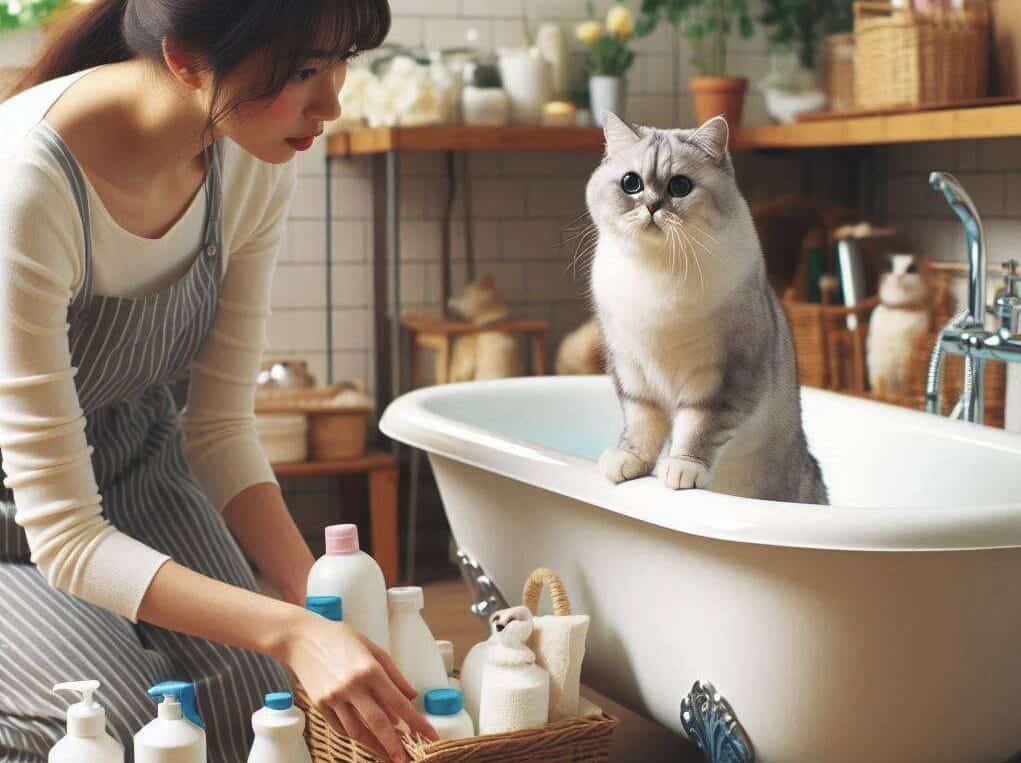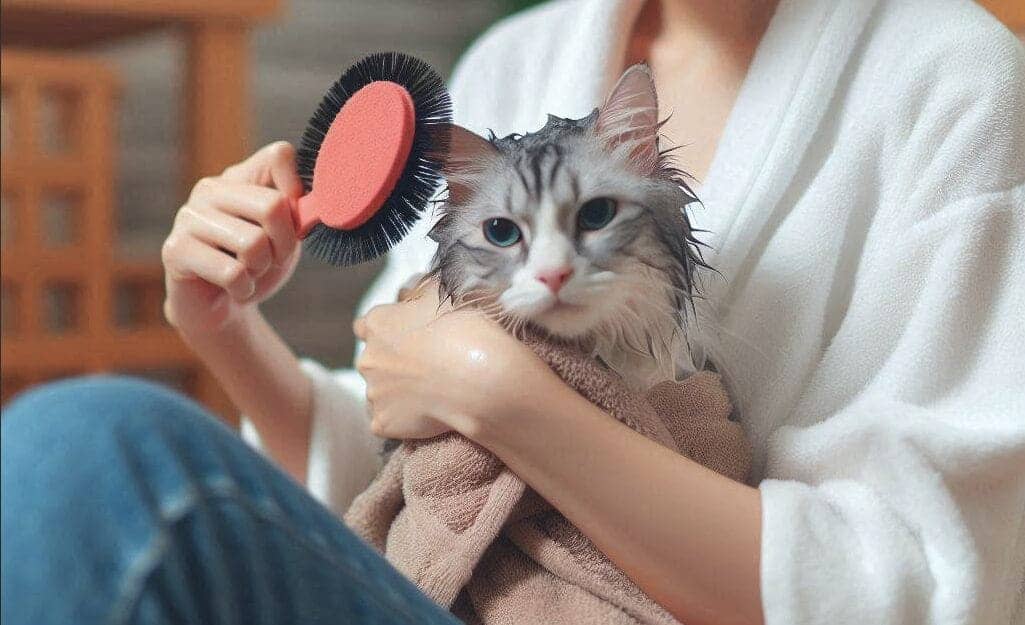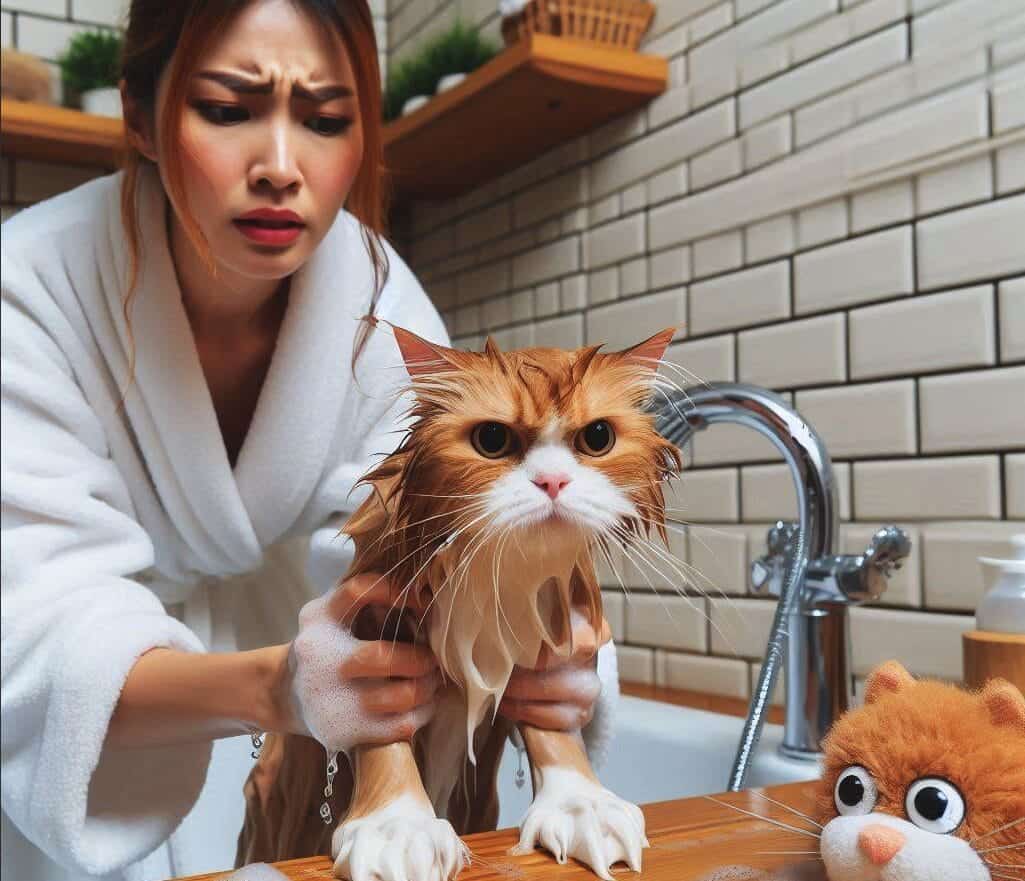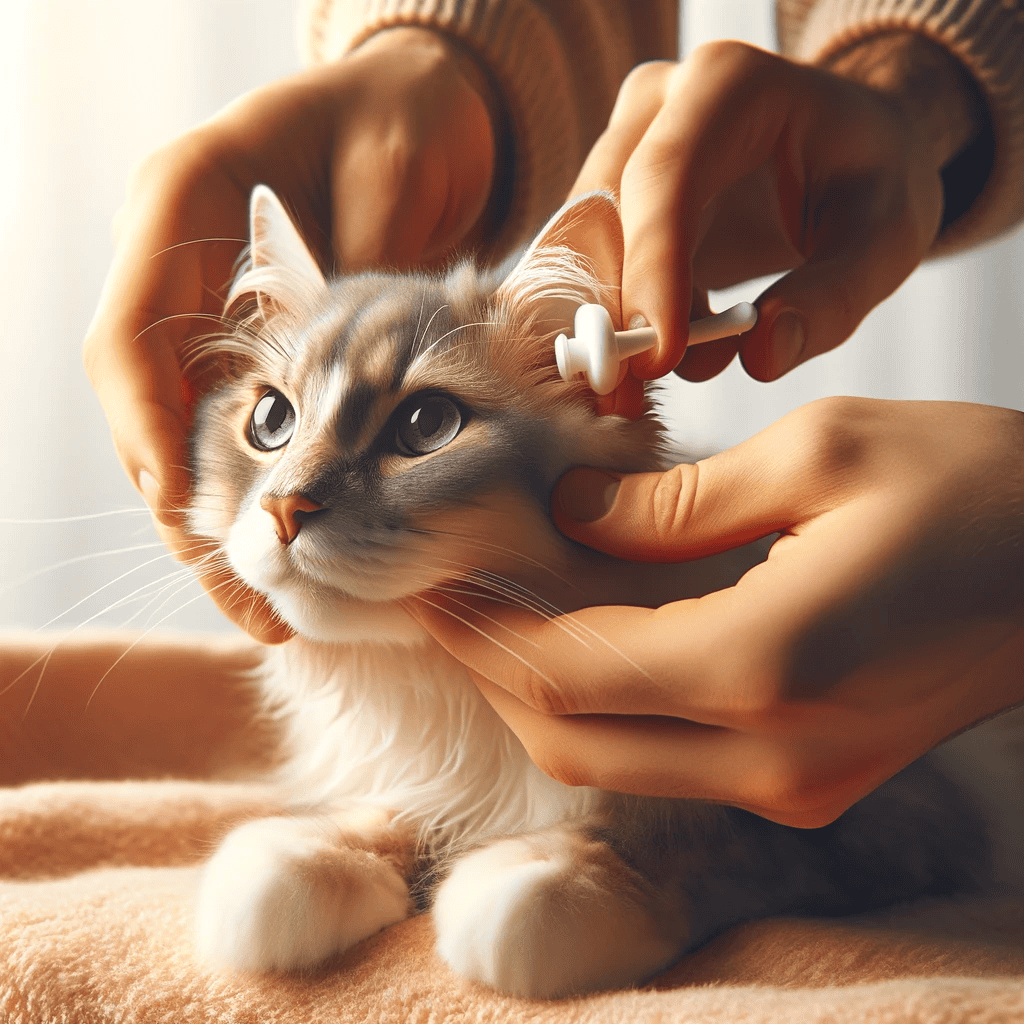As a cat owner, you may have found yourself wondering, “Do I really need to bathe my cat?” It’s a common question, considering that our feline friends are known for their self-grooming prowess.
Did you know that cats spend up to 50% of their waking hours grooming themselves? However, there are times when a little extra help from their human companions can make a world of difference in maintaining their health and hygiene.
If you’re feeling apprehensive about bathing your cat, you’re not alone. Many cat owners find the prospect of bathing their feline friends daunting, as cats are notorious for their aversion to water. However, with the right approach and techniques, you can transform this seemingly challenging task into a positive experience for both you and your cat.
In this comprehensive guide, I’ll help you to prepare for the big day and execute the perfect 😸bath. I’ll also go through common challenges and how to tackle them, ensuring that you and your feline friend emerge from the experience unscathed and even closer than before.
So, let’s get started!
Key Takeaways
– Bathing a cat requires patience, preparation, and a positive attitude
– Start by gathering all necessary supplies, including cat-specific shampoo, towels, and brushes
– Trim your cat’s nails and brush their coat thoroughly before the bath
– Use lukewarm water and a gentle touch to avoid stressing or injuring your cat
– Rinse thoroughly to remove all traces of shampoo, and dry with towels or a low-heat dryer
– Reward your cat with treats and affection after the bath to create a positive association
– Consider alternative grooming methods, such as dry shampoo or professional grooming, if your cat is resistant to water baths
– Regular grooming is just one aspect of a comprehensive cat care regimen, along with proper nutrition, exercise, and veterinary care
Round 1: Preparing for the Bath

Before you even think about getting your feline friend near the water, remember to have everything you need within reach. Trust me, the last thing you want is a soggy, soapy cat making a break for it while you’re rummaging around for a towel!
So, let’s start by gathering the essential supplies.
First and foremost, you’ll need a cat-specific shampoo. Human shampoos, even the gentlest ones, can be too harsh for your cat’s delicate skin and coat.
Look for a shampoo that’s pH-balanced for felines and free from harsh chemicals or fragrances. If your cat has sensitive skin or allergies, consult your vet to find the best option.
Next, grab a few fluffy, absorbent towels. You’ll want one to place in the bottom of the sink or tub for traction, and another to wrap your cat in after the bath.
It’s also a good idea to have a few extras on hand, just in case.
Gather necessary supplies
| Supply | Purpose |
|---|---|
| Cat shampoo | Gently cleanses your cat’s skin and coat |
| Towels | Provides traction and helps dry your cat after the bath |
| Brush or comb | Removes tangles and loose fur before the bath |
| Non-slip mat | Prevents slipping and provides a sense of security for your cat |
| Treats | Rewards your cat for good behavior and creates a positive association with bathing |
In addition to shampoo and towels, you’ll want to have a brush or comb handy. Giving your cat a thorough brushing before the bath can help remove tangles and loose fur, making the bathing process much smoother.
Plus, it’s a great opportunity to bond with your kitty and get them relaxed before the main event.
For cats who get a bit skittish in the bath, a non-slip mat can be a lifesaver. Place it in the bottom of the sink or tub to give your cat a sense of stability and security. If you don’t have a mat, a folded towel can work in a pinch.
Finally, don’t forget the treats! Rewarding your cat with their favorite snacks throughout the bathing process can help create a positive association with the experience.
It’s also a great way to keep them distracted and focused on something other than the water.
Choose the right location
When it comes to bathing your cat, location is key. You’ll want to choose a space that’s comfortable for both you and your feline friend, with minimal opportunities for escape.
The bathroom or laundry room are usually the best options, as they’re typically smaller and easier to control.
Before you begin, make sure the room is warm and draft-free. Cats are sensitive to temperature changes, and a chilly room can make the bathing experience even more unpleasant for them. If possible, run a space heater or turn up the thermostat a bit to create a cozy atmosphere.
It’s also a good idea to close the door to the room, even if you’re confident your cat won’t make a run for it.
The sound of running water can be stressful for some cats, and a closed door can help muffle the noise and create a sense of security.
Trim your cat’s nails
If you’ve ever been on the receiving end of a panicked cat’s claws, you know how important it is to trim their nails before the bath.
Even the most docile cats can get a bit feisty when faced with water, and long, sharp claws can do some serious damage.
Ideally, you should trim your cat’s nails a day or two before the bath. This gives them time to adjust to the sensation and reduces the risk of injury during the bathing process. If you’re not comfortable trimming your cat’s nails yourself, consider taking them to a groomer or veterinarian for a professional trim.
When trimming your cat’s nails, be sure to use a sharp, cat-specific nail clipper. Avoid cutting too close to the quick (the pink part of the nail), as this can cause pain and bleeding.
If you’re unsure of how to properly trim your cat’s nails, ask your veterinarian for a demonstration or watch a few online tutorials.
Brush your cat’s coat
As mentioned earlier, brushing your cat’s coat before the bath can help remove tangles and loose fur, making the bathing process much easier. But did you know that regular brushing can also help distribute your cat’s natural oils throughout their coat, promoting a healthy, shiny appearance?
When brushing your cat, start at the head and work your way down to the tail, using long, gentle strokes.
📛 Be sure to pay extra attention to areas where tangles and mats are likely to form, such as behind the ears, under the legs, and around the tail.
If you come across a particularly stubborn tangle, resist the urge to yank or pull on it. Instead, use a detangling spray or conditioner to help loosen the knot, and gently work it out with your fingers or a wide-toothed comb.
If the tangle is too severe, you may need to carefully cut it out with scissors, taking care not to nick your cat’s skin.
Regular brushing not only keeps your cat’s coat looking its best but also helps strengthen the bond between you and your feline friend. Many cats find brushing to be a relaxing, enjoyable experience, and it’s a great way to show them some extra love and attention.
Now that you’ve gathered your supplies, chosen the perfect location, trimmed your cat’s nails, and given them a thorough brushing, you’re ready to tackle the main event: the bath itself. In the next section, we’ll walk you through the step-by-step process of bathing your cat, from wetting their coat to drying them off and everything in between.
So, take a deep breath, put on your patience hat, and let’s dive in!
Round 2: Bathing Your Cat

Alright, it’s time for the main event! You’ve got your supplies ready, your cat is brushed and ready to go, and you’re feeling confident and prepared. Let’s walk through the step-by-step process of bathing your feline friend.
Fill the sink or tub with warm water
The first step is to fill your sink or tub with warm water. Aim for a depth of about 3-4 inches – enough to wet your cat’s coat thoroughly, but not so deep that they feel like they’re swimming.
When it comes to water temperature, think Goldilocks – not too hot, not too cold, but just right. Cats are sensitive to temperature changes, and water that’s too hot or too cold can be uncomfortable or even painful for them. A good rule of thumb is to aim for a temperature that’s slightly warmer than your own body temperature, around 100°F (38°C).
If you’re unsure if the water is too hot or too cold, use your elbow to test it. Your elbow is more sensitive than your hands, so it’s a better gauge of how the water will feel to your cat. If it feels comfortable to your elbow, it should be just right for your feline friend.
Place your cat in the water
Now comes the moment of truth – getting your cat into the water. This can be a bit tricky, especially if your cat is not a fan of baths. The key is to remain calm and confident, and to use a firm but gentle touch.
Start by gently lowering your cat into the water, hind legs first. This allows them to get used to the sensation of the water gradually, rather than being suddenly submerged. Use one hand to support their chest and front legs, and the other to guide their hind legs into the water.
If your cat starts to struggle or panic, don’t force them to stay in the water. Instead, take a break and let them calm down before trying again. You can also try using a washcloth or sponge to wet their coat gradually, rather than submerging them completely.
| Technique | Purpose |
|---|---|
| Lower hind legs first | Allows cat to get used to water gradually |
| Support chest and front legs | Provides a sense of security and stability |
| Use a washcloth or sponge | Allows for gradual wetting of coat |
| Take breaks as needed | Prevents overwhelming or panicking the cat |
Wet your cat’s coat thoroughly
Once your cat is in the water, it’s time to get them wet from head to tail. Use a cup or a gentle spray hose to wet their coat thoroughly, taking care not to get water in their eyes, ears, or nose. Start at the neck and work your way down the body, using your fingers to massage the water into their coat. Pay extra attention to areas where dirt and grime tend to accumulate, such as the belly, legs, and tail.
If your cat has a particularly thick or long coat, you may need to spend a bit more time wetting it thoroughly. Use a comb or your fingers to work through any tangles or mats, and make sure the water reaches all the way to the skin.
Apply cat shampoo
Now that your cat’s coat is thoroughly wet, it’s time to apply the shampoo. Start by squeezing a small amount of shampoo into your palm – a little goes a long way, so don’t overdo it.
Gently massage the shampoo into your cat’s coat, starting at the neck and working your way down to the tail. Use your fingers to work the shampoo into a lather, paying extra attention to areas where dirt and grime tend to accumulate. Be sure to avoid getting shampoo in your cat’s eyes, ears, or mouth. If you accidentally get some shampoo in these areas, use a damp washcloth to gently wipe it away.
When shampooing your cat, it’s important to use a product that’s specifically designed for felines. Human shampoos, even the gentlest ones, can be too harsh for your cat’s delicate skin and coat. Look for a shampoo that’s pH-balanced for cats and free from harsh chemicals or fragrances. If your cat has sensitive skin or allergies, consider using a hypoallergenic or oatmeal-based shampoo. These formulas are gentle and soothing, and can help alleviate itching and irritation.
Rinse the shampoo thoroughly
Once you’ve worked the shampoo into a lather, it’s time to rinse it out thoroughly. This is perhaps the most important step in the bathing process, as any leftover shampoo can irritate your cat’s skin and cause discomfort.
Use a cup or a gentle spray hose to rinse the shampoo out of your cat’s coat, starting at the neck and working your way down to the tail. Be sure to use plenty of water, and keep rinsing until the water runs clear and you can’t feel any more suds. Pay extra attention to areas where shampoo tends to accumulate, such as the armpits, groin, and under the tail. These areas can be difficult to rinse thoroughly, so take your time and be sure to get all the shampoo out.
If your cat has a particularly thick or long coat, you may need to spend a bit more time rinsing to ensure that all the shampoo is removed. Use your fingers to work through any tangles or mats, and make sure the water reaches all the way to the skin.
Dry your cat
Once you’ve rinsed all the shampoo out of your cat’s coat, it’s time to dry them off. Start by gently squeezing excess water out of their coat with your hands, being careful not to wring or twist their fur.
Next, wrap your cat in a large, absorbent towel and gently pat them dry. Don’t rub the towel against their coat, as this can cause tangles and mats.
Instead, use a blotting motion to absorb as much water as possible.
If your cat has a long or thick coat, you may need to use more than one towel to get them fully dry. You can also try using a pet-specific blow dryer on a low, cool setting to speed up the drying process. Just be sure to keep the dryer moving and avoid getting too close to your cat’s skin, as this can cause burns or discomfort.
| Drying Method | Pros | Cons |
|---|---|---|
| Towel drying | Gentle, easy to do at home | Can take a long time, may not get cat fully dry |
| Blow drying | Fast, can help prevent matting | Noisy, may scare some cats, can cause burns if used improperly |
| Air drying | Natural, no equipment needed | Takes a long time, cat may get cold or uncomfortable |
When drying your cat, be sure to pay extra attention to areas where moisture tends to accumulate, such as the ears, paws, and under the tail. These areas can be prone to infection if left damp, so be sure to dry them thoroughly.
Once your cat is mostly dry, you can let them finish air drying on their own. Provide a warm, cozy spot for them to rest and recuperate, such as a soft towel or a pet bed. Most cats will groom themselves to finish the drying process, so don’t be alarmed if you see them licking and preening themselves more than usual.
And there you have it – you’ve successfully bathed your cat! Give yourself (and your feline friend) a big pat on the back for a job well done. In the next section, we’ll discuss some important post-bath care tips to keep your cat healthy, happy, and looking their best.
Round 3: After the Bath

Congratulations! You’ve successfully navigated the sometimes treacherous waters of bathing your cat. 🙌🏼
But your job isn’t quite done yet. The post-bath period is just as important as the bath itself when it comes to keeping your feline friend healthy, happy, and looking their best.
Reward your cat
First things first – give your cat some love! Bathing can be a stressful experience for even the most easy-going felines, so it’s important to reward them for their bravery and good behavior.
Offer your cat some of their favorite treats, or spend some extra time petting and snuggling with them. This will help create a positive association with the bathing process, making it easier for both of you the next time around. If your cat is particularly food-motivated, you can even try using treats as a distraction during the bath itself. Place a few treats on the edge of the sink or tub, and let your cat focus on nibbling them while you work on washing and rinsing their coat.
Brush your cat’s coat
Once your cat is dry and relaxed, it’s time to break out the brush again. Brushing your cat’s coat after a bath can help distribute their natural oils, prevent matting and tangles, and keep their fur looking shiny and healthy. Start by using a wide-toothed comb to gently work through any remaining tangles or mats. Be extra careful around sensitive areas like the belly, legs, and tail, and use a detangling spray or conditioner if needed.
Next, switch to a bristle or slicker brush to smooth and shine your cat’s coat. Brush in the direction of hair growth, using long, gentle strokes. If your cat has long or thick fur, you may need to use a few different brushes to get the job done.
| Brush Type | Best For |
|---|---|
| Wide-toothed comb | Detangling and removing mats |
| Bristle brush | Smoothing and shining short to medium coats |
| Slicker brush | Removing loose fur and debris from long or thick coats |
| Pin brush | Detangling and smoothing long or thick coats |
Regular brushing not only keeps your cat’s coat looking its best, but it also helps stimulate blood flow to the skin, promoting overall health and well-being. Plus, it’s a great way to bond with your feline friend and show them some extra love and attention.
Keep your cat warm1
Cats are notorious for their love of warmth and coziness, and this is especially true after a bath. Even if you’ve done your best to dry them off, your cat may still feel a bit damp and chilly, so it’s important to provide them with a warm, comfortable place to rest and recuperate.
If it’s cold outside or your home is particularly drafty, consider placing a warm towel or blanket in your cat’s favorite sleeping spot. You can also use a pet-safe heating pad or a self-warming cat bed to provide extra warmth and comfort. If your cat is prone to getting cold easily, you may want to invest in a few cozy sweaters or jackets for them to wear after baths or during the colder months. Just be sure to choose a garment that fits properly and allows for easy movement and grooming.
In addition to providing physical warmth, it’s also important to create a sense of emotional warmth and security for your cat after a bath. Give them plenty of attention and affection, and let them choose when and where they want to be touched. Some cats may prefer to be left alone to groom and relax on their own, while others may crave extra snuggles and playtime.
The key is to be patient and understanding, and to let your cat set the pace for post-bath activities. With a little extra TLC, your feline friend will be back to their normal, purring self in no time!
Challenges and Tips

Even with the best intentions and preparation, bathing a cat can sometimes come with its fair share of challenges. In this section, we’ll discuss some common issues that cat owners may face during the bathing process, and offer some tips and tricks for overcoming them.
Dealing with a resistant cat
Let’s face it – not all cats are thrilled about the idea of taking a bath. Some may squirm, struggle, or even try to escape at the first sign of water. If you find yourself dealing with a particularly resistant feline, don’t despair! There are a few things you can do to make the process easier on both of you.
First and foremost, try to stay calm and patient. Cats are highly attuned to our emotions, and if you’re feeling stressed or frustrated, they’ll pick up on that and become even more agitated. Take a few deep breaths, speak in a soothing voice, and try to project an air of confidence and calm.
If your cat is particularly squirmy, consider enlisting a helper to hold them gently but firmly while you work on washing and rinsing their coat. You can also try using a harness or a grooming loop to keep them securely in place, but be sure to supervise closely and never leave them unattended. If all else fails, it may be time to consider alternative grooming methods (more on that in a bit). Some cats simply do better with dry shampoo or wipes, while others may benefit from a professional grooming session with a trained expert.
Bathing long-haired cats
Long-haired cats, such as Persians, Maine Coons, and Ragdolls, require a bit of extra care and attention when it comes to bathing. Their luxurious coats can easily become tangled, matted, or weighed down with dirt and debris, making the bathing process a bit more challenging. To make things easier, start by thoroughly brushing your cat’s coat before the bath. This will help remove any loose fur, tangles, or mats, and make it easier to work the shampoo through their coat.
When it comes time to wash, be sure to use a shampoo specifically designed for long-haired cats. These formulas are typically more concentrated and have added conditioners to help detangle and smooth the coat. Use your fingers to work the shampoo through your cat’s coat, paying extra attention to areas where mats and tangles tend to form. Rinse thoroughly, using plenty of water to ensure that all the shampoo is removed.
After the bath, use a wide-toothed comb or a slicker brush to gently detangle your cat’s coat. You may need to work in sections, starting at the ends and gradually working your way up to the roots. If you encounter any particularly stubborn knots, use a detangling spray or conditioner to help loosen them up.
Alternatives to water baths
If your cat simply won’t tolerate water baths, or if you’re looking for a quick and easy way to freshen up their coat between full washes, there are a few alternatives to consider.
| Alternative | Pros | Cons |
|---|---|---|
| Dry shampoo | Easy to use, no water required | Can leave residue on coat, may not remove all dirt and odors |
| Grooming wipes | Convenient, gentle on skin and coat | May not be suitable for heavy soiling or matting |
| Professional grooming | Thorough, stress-free for cat | Can be expensive, requires transportation to groomer |
Dry shampoo is a powder-based product that can be sprinkled onto your cat’s coat and then brushed out, taking dirt and odors with it. It’s a great option for cats who hate water, or for quick touch-ups between baths. Just be sure to choose a formula that’s specifically designed for cats, and avoid getting it in their eyes, nose, or mouth. Grooming wipes are another convenient option for spot-cleaning or freshening up your cat’s coat. These pre-moistened wipes are gentle on the skin and coat, and can help remove dirt, dander, and light odors. They’re especially handy for cleaning paws, faces, and other hard-to-reach areas.
Finally, if you’re really struggling to bathe your cat at home, it may be worth considering a professional grooming service. Groomers are trained to handle even the most resistant cats, and they have all the tools and products needed to get your feline friend looking and feeling their best. Plus, it can be a stress-free option for both you and your cat, as you won’t have to worry about the mess or the struggle of doing it yourself.
Summing Up
Bathing a cat may seem like a daunting task, but with the right preparation, techniques, and attitude, it can be a positive experience for both you and your feline friend. By following the steps outlined in this guide, you’ll be able to keep your cat clean, healthy, and happy – and maybe even enjoy some extra bonding time in the process. Remember, every cat is different, and what works for one may not work for another. Be patient, be flexible, and be willing to adapt your approach as needed. With a little trial and error, you’ll soon find the grooming routine that works best for you and your furry companion.

In her previous life, Lisa traveled extensively, both for work and leisure. After the pandemic struck, Lisa locked up her luggage and adopted a cat ever since.
Lisa is now an avid cat lover, she devotes most of her free time serving as butler to her adorable feline at home. When she is not with her cat, she can be seen using her phone sourcing for the latest cat supplies online.


